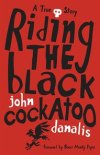Riding the black cockatoo by John Danalis

Allen and Unwin, 2009. ISBN 9781741753776
This true story starts with John, a mature age white Australian, taking
a token 'indigenous writing' course as part of his university studies
in 2005. In one of his tutorials, he inadvertently blurts out; 'That's
nothing: I grew up with an Aboriginal skull on my mantelpiece'. The
shocked reactions from his fellow classmates cause ramifications that
take John, and his family, on a long journey of introspection.
Growing up in the 60's and 70's John had never thought to ask why an
Aboriginal skull, named 'Mary' was displayed on the family mantelpiece.
With amazing honesty John recalls the prejudices, not only the general
ones of the times, but of those of his parents. He states that'do
gooders were tolerated. Abo-lovers were despised,' and that interaction
with aboriginals was a one way mirror. One looked but didn't interact.
Such was the insidious nature of racism in Australia at the time.
John's decision to return 'Mary' from Melbourne to her Wamba Wamba home
near Swan Hill took him on a long self-discovery tour of Aboriginal
history and culture. His recollections are riveting and educate
the reader equally well. He examines how institutions like museums
often regarded aboriginal remains as trophies and were reluctant to
hand them back. We learn that aboriginal people are often reported
falsely in the media. Even on the two dollar coin a generic
aboriginal caricature is used, not a specific individual, as happens
when white people are depicted. The patience, generosity and
forgiving attitude of most aborigines is illustrated again and again.
The ceremonial handover of the skull reconciles past and present for
John and his parents. His father said afterwards, 'I've had to rethink
60 years of attitude'. John becomes somewhat obsessed with chasing more
information on the aboriginal culture and this leads to some personal
problems. His journey is well summarised in the statement,
'you're just a whitefella who's learnt to listen.'
This unique book should be required reading in all upper secondary
classes, and especially Australian history. Teacher's
notes are
available via the publisher's website. Australians who grew up in
the 1960-70's will also find great interest in this book.
Kay Haarsma